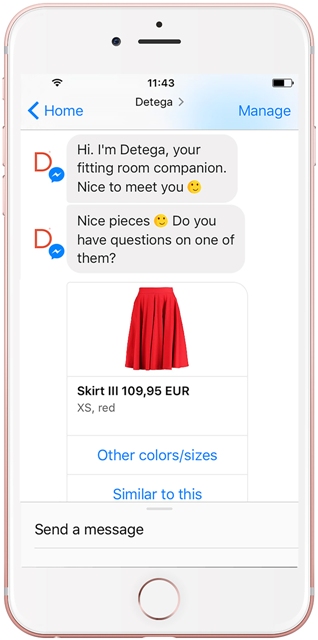Is artificial intelligence fiction or fad?

People are starting to get to grips with the concept of artificial intelligence (AI) and how it can help retail: particularly online, where chatbots, search engines and product recommendation tools are already blazing a trail. But with up to 90% of sales still emanating from bricks-and-mortar storesand only a few practical use cases of AI in retail, Michael Goller, chief technology officer at retail tech specialist Detego, explains how machine learning can really make its mark in the fashion retail sector.
There’s a lot of talk about artificial intelligence at the moment, but not that many practical use cases, especially in bricks-and-mortar retailing. We should know. We were one of the early adopters of machine learning in the development of our retail software and have launched a popular chatbot tool to help consumers get quick answers to simple stock enquiries without having to seek out a sales assistant or call customer service.
Aside from a general foreboding that there’s more talk about AI than action and that machines might eventually outperform humans, we get the distinct impression that most retailers are still trying to understand the basics about what machine learning can actually do for their business and how AI will help with consumer engagement. So, here’s our attempt to unravel the mysteries behind the topic of artificial intelligence in retail and see whether it’s a passing fad, or something retailers should be paying more attention to.
Knowing your product
There is one field where artificial intelligence has already made a significant difference, and that’s getting to grips with vast amounts of data and making much more informed product recommendations. It’s a technique that was spearheaded online by the likes of Amazon – making suggestions about what other products you might like – but still has a long way to go on the high street.

There just isn’t a very joined-up approach between the worlds of online and bricks-and-mortar retailing. And the availability of products is often neglected – not many retailers take into consideration what products would be best (or most profitable) to shift.
That’s where AI comes in. Artificial intelligence, by amalgamating lots of data and making decisions based on a variety of factors – product availability, purchase history, current trends, profitability, and so on – gets better and better at making reasoned choices. All this might sound obvious, but it’s something very few retailers actually do in their stores. Most retailers still have rather disjointed processes across various channels and different departments suffer from a lack of data input on a consistent level.
Some processes are semi-automated, but many – such as merchandise planning and product assortments – remain largely manual. For example, buyers still base most of their decisions on out-of-date sales figures and gut instinct, rather than using much more efficient machine learning tools.
Artificial intelligence is ideally suited to forecasting and stock allocation. These processes historically tend to be quite manual and cumbersome and generally are not managed that efficiently – largely because it’s just too much work to find the ideal mix. It’s something that’s typically done by relatively small departments, even though product selection and stock availability is clearly so fundamental to a retailer’s bottom line. Yet self-learning mechanisms can be put in place to maximise availability and promote what’s most likely to sell.
In most stores today, store staff are prone to stack shelves based on whatever available sizes there are and what will fit, rather than having technology that knows what will be best for that particular store’s profit. By using AI, we’ve found that different stores even in the same town might require completely different sizes of garments to maximise their sales.
Coupled with RFID tags on every item to help monitor stock with near 100% accuracy, artificial intelligence can be used to improve on delivery performance and the distribution of inventory between stores, the warehouse and even to the consumer. For example, we found one retailer flummoxed by hundreds of cartons of products having been shipped but never received and various departments spending a long time trying to resolve – something a machine could unravel in seconds.
It’s not uncommon for retailers to not know exactly where stock is at any particular time, but the joy of artificial intelligence is ensuring that human mistakes are minimised and promises – such as a marketing campaign offering the latest product release at a special price in chosen stores – are always fulfilled.
Human machines

Michael Goller
While there’s still a lot of hype about chatbots at the moment – robots to help with customer service – and undue pressure to adopt some of the latest (and arguably more advanced) techniques inherited from the online retail world, this is just the start of what can be done regarding artificial intelligence in retail.
Chatbots, available on people’s smartphones for asking advice when they enter a store, can give an instant link to customer services and access to a much wider catalogue of products and services. The appeal of chatbots has not only come about because young people in particular are now used to dealing with them online; but also because a lot of people don’t really want to have to track down a sales assistant in a busy store and then get the ‘don’t know’ or ‘don’t care’ response that can ruin a retailer’s reputation.
Simple, product related tasks and stock checks are ideally suited to machines. We’ve even found sales conversion rates to be up to 5% higher in stores where we’ve introduced chatbots with AI-powered product recommendation tools.
Clearly, chatbots won’t ever replace humans working in stores. But they can certainly complement them: often proving more reliable; never prone to sickness or breaks; not trying to drag you into a conversation and oversell; and always available, 24/7.
Increased stock transparency and profitability, as well as better customer engagement, are what will help keep retailers flourishing – allowing them to compete with the increasing threat of online retail goliaths who are setting the trends for the future of shopping. Artificial intelligence isn’t just another fad. It might seem like fiction, but it’s clearly here to stay, outperforming expectations all the time.
The author of this blog is Michael Goller, chief technology officer at retail tech provider Detego
Comment on this article below or via Twitter @IoTGN
